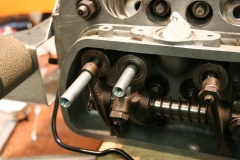Posted on 25/10/2016 at 00:30
Elvira : Rebuilding the 36hp, episode 6 : Rocker arm geometry


episode 6 : Rocker arm geometry
Since I've milled 3.2mm into each head, the whole engine is now 6.4mm less large...
So, I gotta shorten them pushrods! (and that's just the beginning...)
On 36HP engines, contrary to more recent T1, the lifter and the pushrod are one single part...
I start by making myself an adjustable pushrod to find out the right length : I grab an old pushrod, cut it in the middle, throw at it a length of threaded rod and a couple of nuts, and I'm ready to rumble. Next, I install a dial gauge to measure the total lift ; I measure 7.76mm at the valve, which is relevant with what I obtained with my camshaft measuring bench (check article here). I then turn the crank until I'm at half-lift (that is 3.88mm) : while in this position, the pressure screw on the rocker hs to be perfectly aligned with the valve stem.
Side note: some of you may argue that this shouldn't be measured at half-lift, but at the angle at which the valve has the maximum linear acceleration, as this is when you get the most mechanical constraints. From a mechanical stand point, that's right... But come on, this is just a 36HP, with chewing-gum valve spring, not a 2.4L with adamantium double valve springs running at 8000 RPM. The half-lift willl definitely but a good-enough approximation!
Anyway, I adjust the length of my pushrod, tryin to get the lifter in the correct position... Try, remove the lifters, adjust the rod, put back the lifters... After the 3rd try I had the correct length : 299.2mm, while the pushrods are initially 302.3mm long. That's 3.1mm I gotte take off of each pushrod ; it makes sense, since I got my heads lower by 3.2mm on one side, and 3.15mm on the other. To shorten the pushrods, I first remove the lifter part : it's pretty easy, you jut need to put the rod in a vise (in between two pieces of wood not to scratch it), and give a firm tap with a bronze piece on the lifter. The rods are then lathed down, using a W20 8mm collet. I also remove short of a 1/10th on the diameter over 12mm of length, unless you can't put back the rod into the lifter (trust me, I bent 5 of them trying). I suppose they had a machine at the VW factory that would hold the whole length of the rod to prevent bending.
To make sure the pushrod isn't bent afterwards, I just put it back into the engin case, and make it turn between my fingers : if it's still straight, it will remain centered into the tube! Obviously, don't push it all the way into the case, unless the flat side on the lifter will prevent you from making it turn. Pour vérifier que la tige n'est pas pliée une fois le poussoir : on la remet dans le bloc et on la fait tourner du bout des doigts : si elle reste bien centrée dans le tube enveloppe, c'est qu'elle est droite! Evidemment, il ne faut pas la rentrer à fond, sinon le méplat sur le poussoir empêche de la faire tourner.
Historical side-note
The pushrods on 36HP engines may contain a piece of wood inside (made out of beech wood) : actually that's known to be the only piece of wood in a beetle! (well, if you ignore the convertible tops obviously)My pushrods didn't have that piece of wood inside ; but I had another one (gift from Eric SIMON) which did contain that rod. But the actual role of this rod has never been really established...
(Edit 20161103 : Oops, forgot to add pictures right here!) I've read different theories on the subject :
- To make oil go up to the rockers thanks to capillarity effect : I don't buy it. No pressure, no flow, and the oil would actually drip back into the rod. Nope, not happening.
- Pumping effect due to the wooden rod going up and down into the pushrod... I don't believe it either, there's an actual oil pump pushing behind, I don't see how that would work.
- To dampen the vibrations and limit distribution noise by absorbing some of the harmonics : well, why not, could be.
- To limit the oil volume in the push rod. Thus limiting the weight of the pushrod, making the whole distribution lighter. Plus, upon starting the engine, you'd have less volume to fill up, meaning faster pressure build up. That could make sense ; the flow is anyway limited by the hole diameter on the lifter and on the rocker side : no actual need for the pushrod to be filled up with oil.
That's all folks, to be continued soon!
1

















